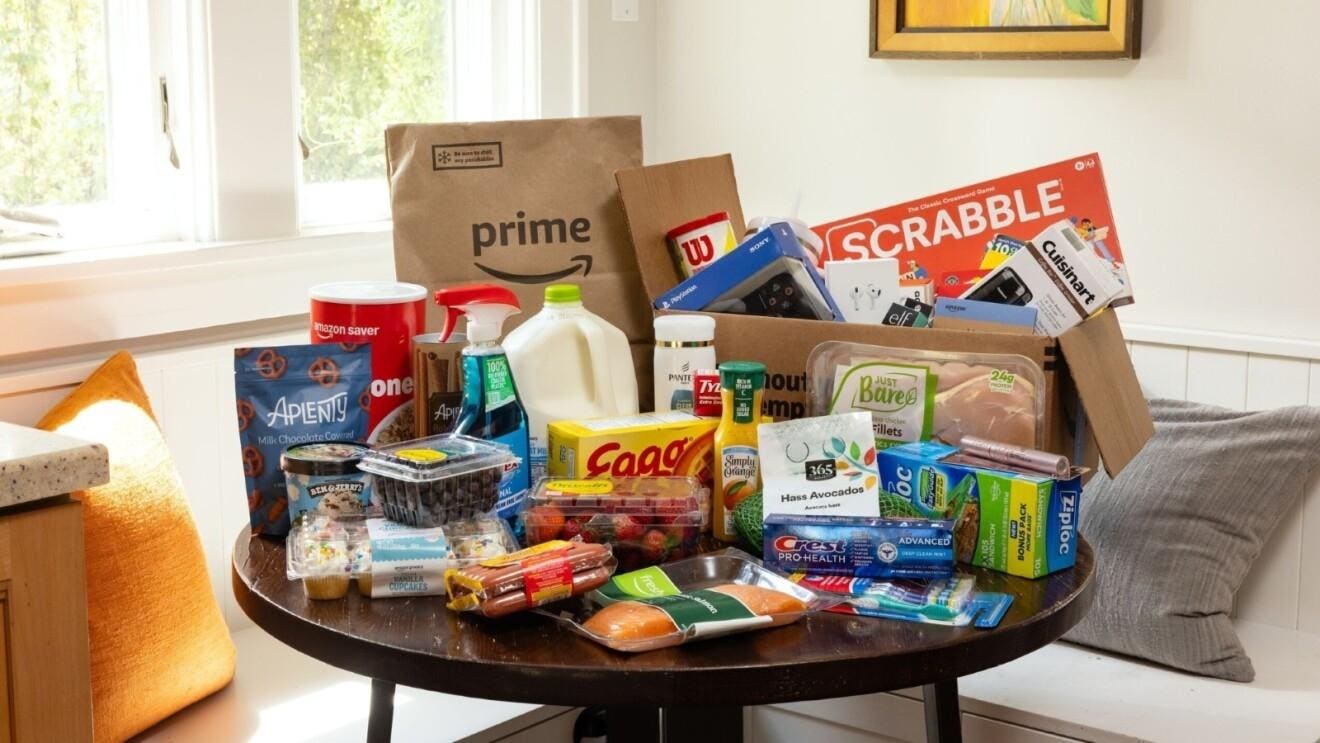With Amazon’s new same-day grocery service, groceries and other Amazon orders can arrive together in a single delivery.
Amazon
Amazon recently announced a major expansion of its same-day delivery service, integrating thousands of fresh grocery items into its existing U.S. logistics network. Customers in more than 1,000 cities can now order perishable items, including produce, meat and dairy, alongside millions of other Amazon products, with delivery within hours. This strategic move aims to unify the company’s diverse retail operations and leverage its technological infrastructure for a more integrated customer experience. Amazon plans to expand the service to 2,300 U.S. locations by the end of 2025.
Earlier this year, I attended a small analyst meeting with Amazon Stores executives in Seattle to discuss the company’s strategy and upcoming plans. My key takeaway from that event is that the core of Amazon’s strategy is to increase speed while lowering its cost to serve. (Pretty simple, right? Faster but cheaper.) The company reduces per-unit delivery costs by improving delivery times and consolidating orders into a single fulfillment process. This operational efficiency is especially critical for low-margin categories such as groceries. Amazon says the improved cost structure allows it to price products competitively and expand its grocery selection.
(Note: My firm, Moor Insights & Strategy, has advisory relationships with AWS and the Amazon Devices unit, but no business relationship with Amazon Stores.)
How Does Same-Day Grocery Delivery Bolster The Prime Ecosystem?
By focusing on groceries, Amazon is targeting a high-frequency purchase category that directly enhances the value proposition of its Prime membership. For Prime members, same-day grocery delivery is free on orders over $25, while smaller orders incur a $2.99 fee. (Non-Prime customers pay $12.99.) This pricing model undercuts competitors and is a tangible benefit that could strengthen loyalty among Prime members.
In the bigger picture, groceries and everyday essentials are a core focus of Amazon’s strategy, representing a rapidly growing segment of its delivery business. During my recent Amazon visit, Jamil Ghani, worldwide vice president of Amazon Prime, told me that 2 billion of the 9 billion items delivered in 2024 were groceries and everyday essentials, a 50% increase over the previous year. This aggressive growth highlights the strategic importance of high-frequency purchases as a key driver for Prime membership. As Ghani said, “Our store is meant to be the everything and everyday store, and [Amazon’s]
everyday essentials and grocery strategy is about really bolstering the credential on the ‘everyday’ part of it.”
Prime Strategy Builds On Warehouse Club Blueprint
The underlying logic of Amazon’s Prime membership model has a clear precedent in the retail sector. The wholesale membership retailing pioneer Price Club, founded in 1976 by Sol Price, established the practice of supporting low retail margins through membership fees. When Price Club merged with Costco in 1993, Costco expanded this model by bundling in ancillary benefits for members, including pharmacies, gas stations and optical centers.
The rationale is simple: Customers are less likely to cancel their subscriptions as membership value increases across multiple life needs. Both Costco and Amazon structure their benefits so that members will use them frequently, driving habitual engagement. With Costco’s 92.8% annual renewal rate in the United States and Canada, the company has a stable and predictable membership revenue stream. Membership fees now account for approximately two-thirds of Costco’s net operating income.
For Amazon, Prime’s expanding suite of lifestyle services represents a modern digital parallel. Besides free or low-cost grocery delivery, these benefits include streaming on Prime Video, free shipping on books and household goods and even discounts for healthcare. The Prime Rx prescription savings program offers Prime members discounts of up to 80% on generic medications and 40% on brand-name medications when paying without insurance. The RxPass subscription also offers unlimited eligible generic medicines for a flat monthly fee.
Each of these retailers has used bundled value not simply as a retention tool, but as a driver of habitual use and increased customer lifetime value. This comes on top of outright savings: Amazon Prime members save an average of more than $500 annually on deliveries alone — another compelling reason to stay on Prime.
In a phenomenon that’s known well by millions of American consumers who reflexively open the Prime app any time they’re running low on toilet paper or dog food, this strategic bundling makes the Prime ecosystem an integral part of a customer’s life, creating a buffer against cancellation. Amazon’s commitment to Prime’s value even extends beyond its own marketplace. For example, the company’s “Buy with Prime” feature allows third-party merchants to offer Prime shipping benefits directly on their own websites. This enables Amazon to reinforce the value of Prime membership while competing with e-commerce platforms such as Shopify, even at the potential cost of a direct sale on Amazon’s own e-commerce platform.
According to Ghani, the service’s subscription revenue significantly contributes to the company’s investment pool to fund benefits. “We think of that as our fund to further invest in benefits [and] put more value into the membership,” he said. The company believes this reinvestment deepens member engagement across the entire ecosystem. For instance, Ghani noted, “A member who streams Reacher buys more socks, and a member who comes for Prime Day discovers Amazon Music, and the member who shops grocery for the first time spends a lot more money everywhere, because it’s the frequency and the habituation.”
The Technology Stack Powering Amazon’s Rapid Delivery
The same-day grocery expansion caps years of strategic investment and lessons learned from Amazon’s evolving grocery business. The service is built on a foundation of sophisticated automation and AI systems that manage the flow of goods to the customer.
The infrastructure supporting this expansion includes specialized temperature-controlled fulfillment centers and a vast network of robots and AI systems. Two pillars stand out:
- Robotics and automation: The company’s network deploys more than 750,000 robots (I wrote about Amazon’s robotics ambitions earlier this year), including autonomous mobile robots that transport pods and inventory racks throughout fulfillment centers. AI-powered robotic arms with names such as Sparrow and Cardinal use computer vision and machine learning to pick and sort individual items. At the same time, the company is developing an agentic AI framework to enable robots to understand natural language commands for more autonomous operations.
- AI for logistics and forecasting: The company’s Wellspring generative AI system creates precise delivery maps by integrating data from satellite imagery, street views and building blueprints. This capability is designed to increase the efficiency and accuracy of last-mile delivery. A foundational AI forecasting model analyzes a wide range of data, including historical sales, localized trends and real-time variables like weather, to predict customer demand more precisely. This allows Amazon to strategically position inventory closer to customers and reduce delivery times.
The service also incorporates a six-point quality check system for perishables, with temperature-sensitive goods transported in recyclable insulated bags. Crucially, this is the same technology developed over several years for Amazon Fresh and Whole Foods deliveries.
What Led To Amazon’s Pivots And Its ‘One Grocery’ Strategy?
Amazon’s current approach is the result of years of strategic pivots and learnings from past industry failures, including Webvan’s spectacular collapse in 2001. The company hired four former Webvan executives, including current Amazon Stores CEO Doug Herrington, to ensure it avoided the rapid expansion and infrastructure mistakes that destroyed the pioneering grocery delivery service.
The company’s initial forays into grocery began in 2007 with the Amazon Fresh grocery delivery service. A decade later, the company acquired physical locations and established a grocery supply chain through its 2017 acquisition of Whole Foods Market for about $14 billion. Amazon then launched experimental formats such as its cashierless Amazon Go stores. The company kept the Amazon Fresh moniker for its brick-and-mortar grocery stores, which launched in 2020. It is worth noting that Amazon has not yet truly scaled any of its fresh-food retail beyond the existing Whole Foods chain.
The company’s “One Grocery” strategy, unveiled in 2024, represents a deeper consolidation and appears to be its best opportunity yet to scale its grocery business. This new blueprint unified the leadership and fulfillment networks of Whole Foods and Amazon Fresh, with the aim of creating a seamless digital and physical experience for the customer. According to Amazon executives, this unification aims to “hide the wires” of its complex organizational structure, presenting a single, cohesive brand and shopping experience to the consumer.
In my view, while Amazon’s deliberate study of Webvan’s collapse likely provided valuable lessons, it may have also created blind spots. Thanks to Costco’s standout example and its own success with Prime in other product categories since 2005, Amazon already had the membership model blueprint firmly in place — with Prime membership revenue available to subsidize grocery operations. Beyond that, Amazon is one of the few greatest logistics operators in the history of human commerce, and I believe it had the infrastructure to make grocery delivery viable. Yet for over a decade Amazon’s progress in grocery was slow. Is it possible that the very executives hired to avoid Webvan’s mistakes focused so intently on preventing operational errors that they underestimated Amazon’s structural advantages?
Whatever the case, Amazon Fresh remained confined to Seattle for six years, and physical store expansion fell 90% short of the company’s projections.
Competitive Landscape And Future Outlook
Today, by contrast, Amazon’s grocery expansion directly challenges competitors in a substantial delivery sector. The U.S. online grocery market is currently worth $328 billion, and is projected to reach $488 billion by 2030, growing at a CAGR of 8.29%. Amazon faces significant competition, with Walmart leading the online grocery market at 25.7% market share, followed by Amazon at 22.0% and Instacart at 21.6%. The Amazon announcement immediately impacted competitors, with Instacart shares declining 11% and traditional grocers like Kroger and Albertsons dropping 3% to 4% the day of the announcement.
Amazon’s integrated delivery model creates a clear competitive signal for its rivals. This move places Amazon in more direct competition with Walmart and Instacart by lowering friction for customers to buy fresh food alongside non-food items in a single checkout. Prime’s $25 threshold for free delivery also undercuts Walmart’s $35 threshold. The service’s integration with Amazon’s broader catalog also creates operational efficiencies and cross-selling opportunities — for everything from cookware to cookbooks — that competitors may struggle to replicate, potentially leading to industry-wide margin compression.
Amazon’s grocery move is squarely focused on revenue growth and customer retention. In my opinion, the company is also delivering on its promise of making the Prime membership a comprehensive value proposition for its users. The company’s early data shows that customers buying perishables have higher repeat purchases and higher shopping frequency than non-grocery shoppers.
Amazon has structured its platform to deepen member engagement and offset operational costs with subscription income. Drawing from successful membership retail models, while also balancing caution evoked by earlier industry failures, could help Amazon overcome the challenges of online grocery logistics. This approach should allow Amazon to scale its grocery operations in line with evolving consumer expectations and position the company to capture the daily purchase patterns that drive both long-term customer relationships and competitive advantage.
Moor Insights & Strategy provides or has provided paid services to technology companies, like all tech industry research and analyst firms. These services include research, analysis, advising, consulting, benchmarking, acquisition matchmaking and video and speaking sponsorships. Of the companies mentioned in this article, Moor Insights & Strategy currently has (or has had) a paid business relationship with Amazon.









